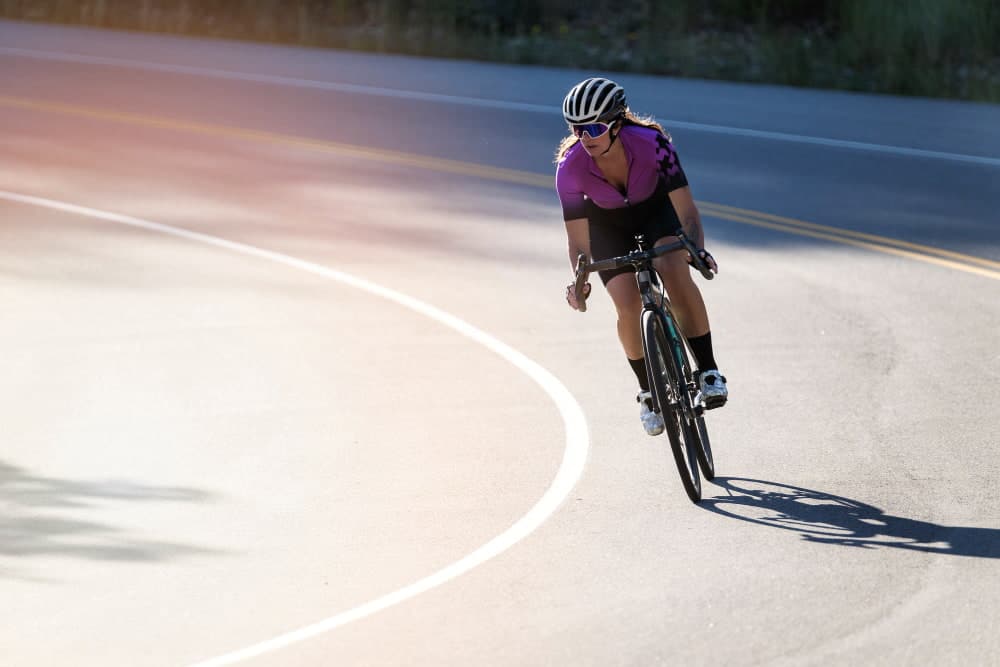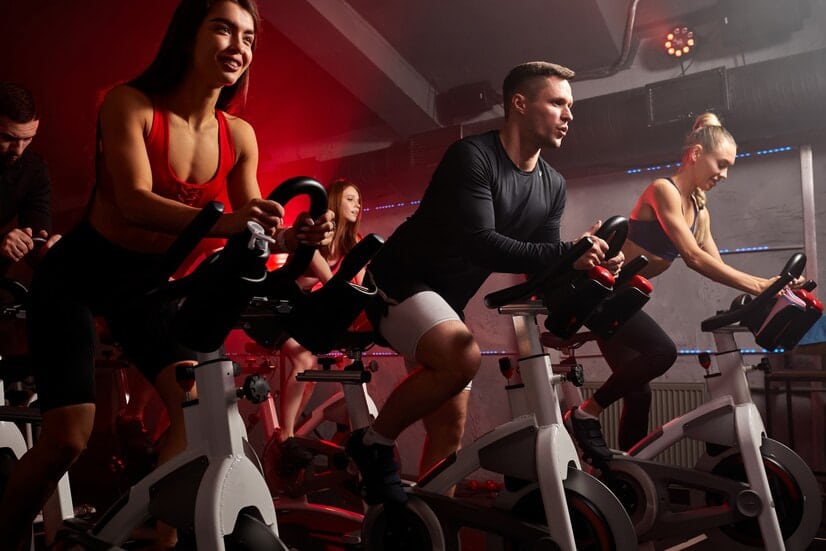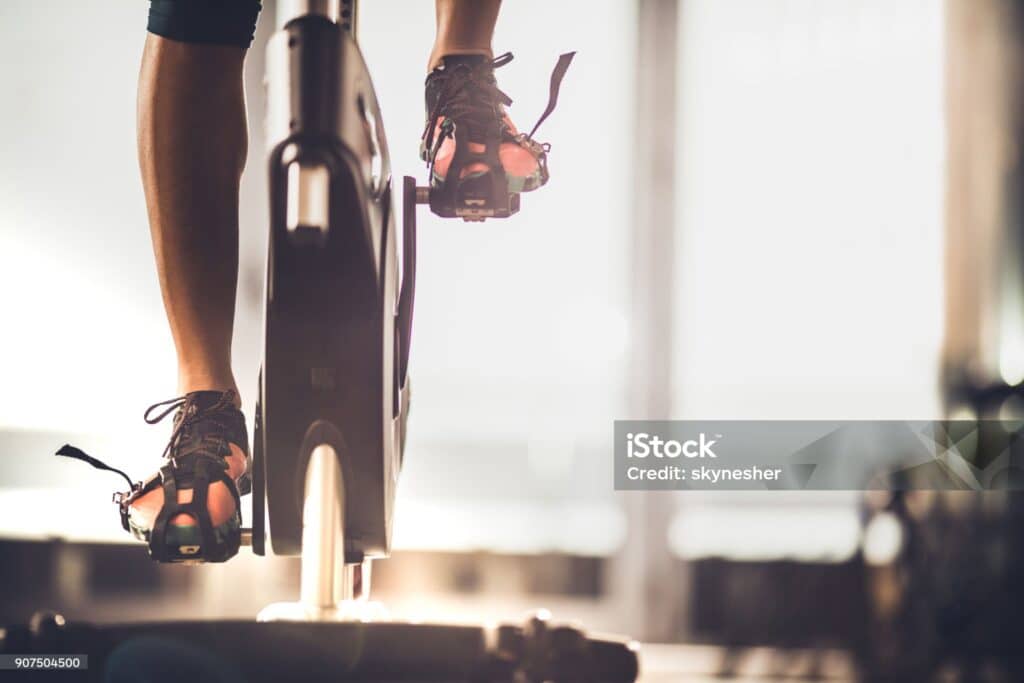
Summary
Welcome » Welcome » Tips for getting started » Leg strength bike: strengthen your legs on the bike
Leg strength bike: strengthen your legs on the bike
Want stronger legs without leaving your bike? This article is for you. Find out how to combine cycling and weight training to optimize your performance.
Summary
Introduction
We explore specific exercises, fundamentals, and nutritional tips to maximize your muscle gains. Learn how to structure your sessions and progress effectively.
Strengthening your legs directly on the bike has undeniable advantages. By combining road cycling training with strength training exercises, you can maximize your performance while strengthening your muscles. This approach not only builds your power and endurance, but also improves your posture and overall efficiency on the bike.
Benefits of combining cycling training and strength training
- Power improvement : By working your muscles in a targeted manner, you increase the force applied to each pedal stroke. This translates into better performance on climbs and during sprints.
- Increased stamina : Stronger muscles better support long rides. You will be able to maintain high cadences over longer distances without feeling excessive fatigue.
- Injury prevention : Balanced and strengthened muscles protect your joints and reduce the risk of common cycling injuries, such as tendinitis and knee pain.
Importance of an integrated approach for cyclists
Taking an integrated approach that combines cycling and strength training is essential for any serious cyclist. This method not only strengthens your legs, it also contributes to better muscle coordination and greater energy efficiency. By incorporating specific strength training exercises into your cycling routine, you promote better load distribution and more efficient use of your muscular resources.
Ultimately, this holistic approach allows you to get the most out of each workout, harnessing the full potential of your muscles. So, are you ready to pedal towards stronger and more powerful legs?
Basic principles for strengthening your legs by cycling
To effectively strengthen your legs while cycling, it is crucial to understand and apply certain fundamental principles. By focusing on resistance, intensity, frequency and duration of sessions, you can optimize your training and achieve convincing results.
Resistance and intensity
One of the easiest ways to strengthen your legs is to play with the gears on your bike. By using heavier gears, you increase the resistance with each pedal stroke. This forces your muscles to work harder, especially the quads and glutes. Consider alternating between light gears for recovery phases and heavier gears for intense effort phases.
The intensity of your cycling sessions also plays a crucial role in muscle development. Incorporating high-intensity intervals, such as short sprints, into your training can put more strain on your muscle fibers. These intense efforts, followed by active recovery periods, help improve the power and endurance of your muscles.
Frequency and duration of sessions
For optimal results, it is recommended to vary the frequency and duration of your sessions. weight training on the bike. A good practice is to include specific resistance and intensity exercises at least two to three times per week. Each session can last between 30 and 60 minutes, depending on your fitness level and goals.
- Short but intense sessions : Favor shorter sessions with high intensity to maximize muscle gain.
- Longer, moderate sessions : Combine them with longer outings at moderate intensity to work on muscular endurance.
By alternating these different approaches, you will allow your muscles to develop in a balanced manner, while avoiding overwork and injuries.

Specific exercises on the bike to strengthen the legs
To effectively strengthen your legs while cycling, it is important to integrate specific exercises into your routine. These exercises target different muscle groups and improve both strength and endurance. Here are some key exercises to get strong, sculpted legs.
Short sprints
Short sprints are great for building explosive power in your legs. To perform this exercise, start pedaling at a moderate pace and then break into a maximum sprint for 30 seconds. Focus on pedaling powerfully and quickly.
To maximize benefits, perform 10 repetitions of 30 seconds each, with a minute of recovery between each sprint.
Short sprints primarily work the quads, hamstrings, and glutes, giving you a complete lower body workout.
Dancer climbs
Dancer climbs are great for strengthening your legs. Choose a climb with a moderate to steep slope. Get up from the saddle and pedal in a standing position.
Perform 3-5 minute climbs at a high intensity. Try to maintain a brisk cadence to maximize effort.
This type of exercise particularly targets the quadriceps and calves, while improving your muscular endurance.
Low cadence pedaling
Low cadence pedaling involves maintaining a cadence of 50 to 60 revolutions per minute (rpm). Use heavier gears to increase resistance.
Perform 5-minute sets, repeating the exercise 5 times, with 2-minute breaks between each set.
This type of training intensely uses the quadriceps and glutes, promoting their development and resistance.
Strength-speed exercises
Strength-speed exercises involve sudden accelerations from a slow pedaling position. Start at low speed and accelerate as quickly as possible for 15 to 20 seconds.
Perform 8 to 10 repetitions with a 2 minute recovery between each effort.
These exercises work all of the lower body muscles, including the quadriceps, hamstrings and calves.
Single leg pedaling
Single-leg pedaling helps balance muscle strength. Detach one leg from the pedal and pedal only with the other. Switch legs after each set.
Perform sets of 1 to 2 minutes per leg, repeating the exercise 3 to 4 times for each leg.
This exercise improves muscle coordination and balance, helping to prevent imbalances and injuries.
Structuring a typical session
To maximize the benefits of your training, it is crucial to structure each session correctly. A good strength training session on the bike includes three key phases: warm-up, core session, and cool-down. Here's how to organize each phase for optimal results.
Warming up
Warming up is an essential step to prepare your muscles and avoid injury. A gradual warm-up increases blood circulation, raises body temperature and prepares the joints for exercise.
Start by pedaling at a moderate pace for 10 to 15 minutes. Incorporate a few short 10-second sprints to activate your muscles. You can also include joint mobility exercises, like ankle rotations and light stretches.
Body of session
The body of the session should include a combination of specific exercises to work different muscle groups. Here is an example of a combination:
- Short sprints : 10 x 30 seconds of sprint with 1 minute of recovery.
- Dancer climbs : 5 x 3 minutes uphill with 2 minutes of recovery.
- Low cadence pedaling : 5 x 5 minutes at 50-60 rpm with 2 minutes of recovery.
- Strength-speed exercises : 8 x 20 seconds of brutal accelerations with 2 minutes of recovery.
Alternate high-intensity exercises with periods of active recovery to maintain consistent effort without exhausting your muscles. Active recovery involves pedaling at an easy pace, allowing your muscles to rest while still moving.
Return to calm
Cooling down is just as important as warming up. It allows you to gradually reduce your heart rate and avoid muscle aches. A good cool-down also helps eliminate toxins accumulated in the muscles during exercise.
After your session, cycle at a slow pace for 10 minutes. Next, perform gentle stretches for your quads, hamstrings, calves, and glutes. Hold each stretch for 20 to 30 seconds to release tension and promote muscle recovery.
Progression and periodization
To optimize your results and avoid stagnation, it is essential to follow progression and periodization in your training program. These concepts allow you to adapt the sessions to your level and ensure continuous improvement.
Adaptation of the program according to the level
Adapting your training program according to your level is crucial.
- Beginners : If you are a beginner, start with shorter, less intense sessions. For example, incorporate short sprints and dancer climbs gradually. Allow yourself more recovery time between exercises to allow your body to adapt.
- Experienced cyclists : If you are an experienced cyclist, increase the intensity and duration of your sessions. Add strength-speed and low-cadence pedaling exercises to your routine. Reduce recovery times to increase overall workload.
Training Cycles
To avoid overtraining and maximize gains, it's important to incorporate training cycles into your overall plan.
- Development phase : This phase, which generally lasts 4 to 6 weeks, focuses on increasing the intensity and volume of the sessions. Now is the time to add new exercises and push your limits.
- Recovery phase : Followed by a recovery phase of 1 to 2 weeks, this period allows your body to rest and repair itself. Reduce the intensity of sessions and focus on light exercises and stretching.
Alternation of exercise types over the weeks
To maintain consistent progress and avoid boredom, alternate exercise types each week. For example :
- Week 1-2 : Focus on short sprints and dancer climbs.
- Week 3-4 : Add low-cadence pedaling and strength-speed exercises.
- Week 5-6 : Incorporate single-leg pedaling sessions and increase the duration of dancer climbs.
This alternation allows you to use different muscle groups and work on various physical qualities, such as power, endurance and strength.
By following these principles of progression and periodization, you maximize your chances of seeing significant improvements while minimizing the risk of injury. Adopt these strategies for more effective and sustainable cycling training.
Precautions and advice
To get the most out of your cycling workout while avoiding risks, it is crucial to follow certain precautions and follow sound advice. Here's what you need to know to practice safely and optimize your performance.
Listening to the body
Listening to your body is essential to avoiding overtraining and injury. Pay attention to signs of fatigue such as:
- Persistent muscle pain : Pain that does not go away after a few days of rest may indicate injury or overuse.
- General fatigue : If you constantly feel tired or lethargic, it's a signal that your body needs rest.
- Decreased performance : A noticeable drop in your performance may be an indicator of excessive fatigue or overtraining.
Recovery is an essential component of any training program. Incorporate rest days and active recovery sessions to allow your muscles to repair and strengthen. Use recovery techniques like stretching, foam rolling and ice baths to improve muscle recovery.
Adapted nutrition
Proper nutrition is crucial to support your efforts and promote recovery. Here are some tips to optimize your nutrition:
- Before the effort : Consume a meal rich in carbohydrates 2 to 3 hours before your session to maximize your energy reserves. An example could be whole-wheat pasta with vegetables and a lean protein source.
- During exercise : For long sessions, bring easy-to-digest snacks like energy bars or gels. Make sure you stay hydrated by drinking water or electrolyte drinks regularly.
- After the effort : The recovery phase begins at the end of your session. Eat a snack rich in protein and carbohydrates within 30 minutes of exercise to promote muscle reconstruction. A protein smoothie with fruit and yogurt is a great option.
Protein plays a key role in muscle repair and growth. Make sure to include high-quality protein sources in your daily diet. Recommended sources include:
- Lean meats : Like chicken, turkey and fish.
- Dairy products : Such as yogurt, milk and cheese.
- Plant proteins : Like legumes, nuts and tofu.
By following these precautions and tips, you can maximize the benefits of your cycling training while minimizing the risk of injury and optimizing your recovery. Listen to your body and nourish it properly to achieve your leg strength goals safely and effectively.

Conclusion
Strengthening your legs by cycling is an effective and practical method. By combining resistance, intensity and specific exercises, you optimize your performance. Integrate these principles into your routine for visible results.
Follow a structured program with training cycles adapted to your level. Listen to your body and adopt proper nutrition to promote recovery. This global approach maximizes the benefits of each session.
Discover tous les bienfaits du vélo sur notre blog !
Strengthen your legs with Space
Do you want to combine cycling and bodybuilding? At SPACE CYCLE, our POWER RIDE session combines cardio and muscle strengthening for a complete workout, focused on working on the “core”.
Live an immersive experience at SPACE CYCLE, with a unique light show and an energizing atmosphere, led by our coaches and their exclusive playlists.
Rejoignez-nous dans nos studios de Bonne Nouvelle ou Bastille pour des cours d’indoor cycling comme jamais auparavant !
Read also
RPM combien de fois par semaine : Guide pour optimiser vos séances
Vélo d’appartement bienfaits : pourquoi l’adopter dès maintenant ?
Follow us
on instagram
To follow all our news,
take advantage of our tutorials and participate
in our many contests.
Breaking news!
Receive our newsletter.





